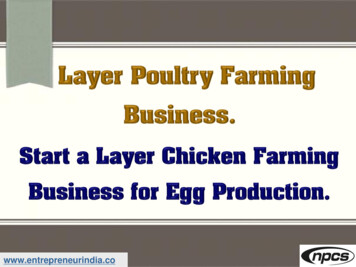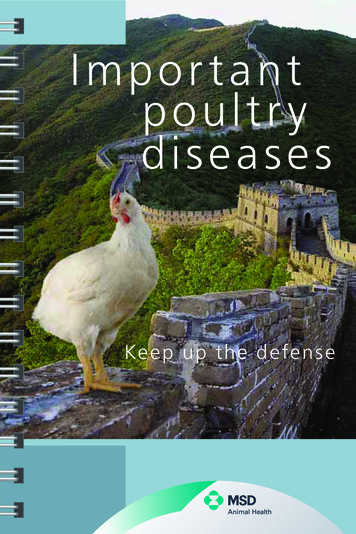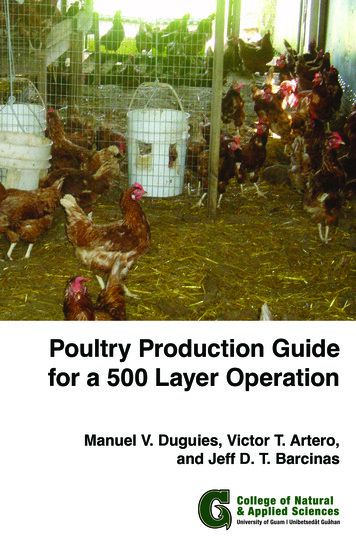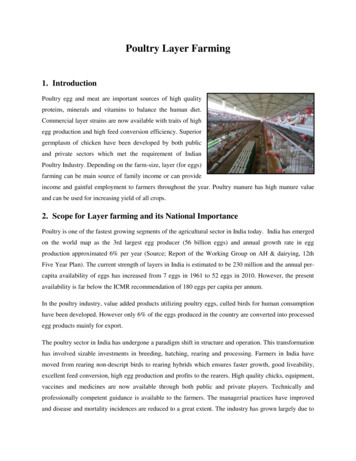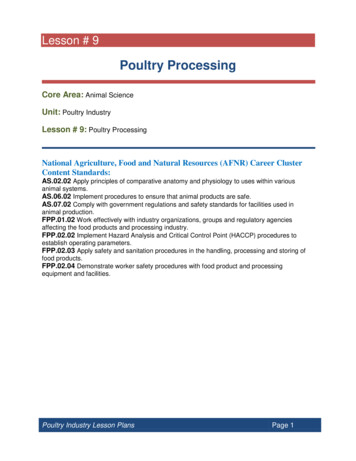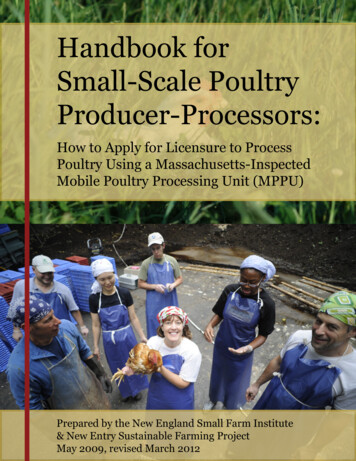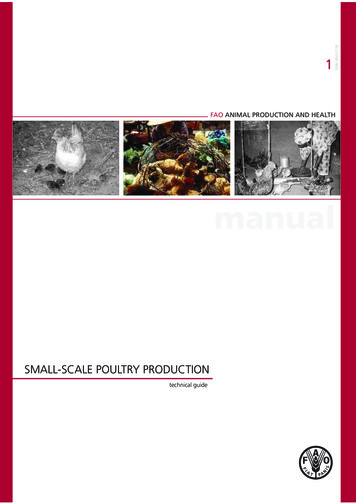
Transcription
FAMILY POULTRY TRAINING COURSETRAINEE’S MANUALPurpose: to provide both women and men with sufficient information and knowledge toallow them to farm poultry in a commercial and semi-commercial way, and to decide ifthey can make money out of the venture.Objectives: to learn about all aspects of raising poultry for their meat and eggs. Then todevelop a business plan which will show them if they can make money out of a poultryfarming enterprise operation in their country or region under the present conditions.Course: there will be trainers who will guide the participants through all aspects ofproducing poultry. There will be ‘hands on’ practical work, visual demonstrations and amanual that will have diagrams, photographs and illustrations. Towards the end of thecourse, commercial poultry production will be dealt with in two specialised areas: 1. Formeat (broiler) production and 2. For egg production.Small scale commercial broiler enterprise2
TABLE OF CONTENTSFAMILY POULTRY TRAINING COURSE .2TRAINEE’S MANUAL .2Purpose .2Objectives .2Course .2UNIT I.11. INTRODUCTION .11.1 What will I learn from this course? .21.2 Why keep chickens? .31.3 The business of poultry farming .41.4 Background information .6UNIT II .72. POULTRY BREEDS.73. Housing.93.1 Floor . 123.1.1 Litter . 124. EQUIPMENT . 144.1 Drinkers . 144.2 Feeders . 14UNIT III . 165. BROODING . 166. FEEDING . 196.1 Choice feeding . 217. HEALTH AND DISEASE PREVENTION . 237.1 Newcastle disease . 257.2 Avian influenza. 26UNIT IV . 278. COMMERCIAL BROILER MEAT PRODUCTION . 278.1 Marketing . 308.2 Manure . 318.3 Record keeping . 31UNIT V . 329. COMMERCIAL EGG PRODUCTION . 329.1 Hatching chicks. 329.2 Artificial incubation . 339.3 Pullets. 359.4 Battery cages . 359.4.1 Small scale semi-commercial cage unit . 369.5 Barn hens . 369.6 Free range . 379.7 Force moulting . 399.8 EGG QUALITY. 409.8.1 Internal . 409.8.2 External quality . 41UNIT VI . 4210. RECORD KEEPING . 4211. CONCLUSION . 4212. FEASIBILITY STUDY . 4213. COOPERATIVES . 4914. COMMUNITY OWNERSHIP . 493
UNIT I1. INTRODUCTIONThere is no point in setting up a farming venture unless it can be sustained; that is, itcan survive over the long term. Therefore it is essential to make a survey in which keyquestions must first be answered honestly before the farmer decides to launch into apoultry enterprise in which he or she will have to invest time and precious money.It is assumed that all trainees have a particular interest, but little information, in settingup a poultry enterprise on a commercial or semi-commercial scale and are here to learnsome basic management skills. It is only from practice and experience that the farmerwill become an efficient poultry producer and this course forms the foundations of asuccessful poultry enterprise.The other important aspect is that the farming of poultry must not harm the environmentby polluting water ways with plastic bags, poultry waste or chemicals used in thefarming industry for example. Each one of us has the responsibility to protect andimprove the land we farm.Any poultry farm will usually be part of a farming system (vegetables, plantation crops,gardens, special crops, trees, other livestock) and all parts must be catered for andmust not be compromised. In other words a new poultry venture will likely be part of theexisting system.1
(a) Your first task is to introduce yourself and give ussome information on your background. We would liketo know what you do, why you are here and a littleabout your village and family(b) Now that we know a little about you I will tell you abit about myself(c) I am sure that you may have some questions toask. These may relate to the course or to any othermatter. So please ask them1.1 What will I learn from this course?At the end of the course you should understand the basic facts about keeping poultry foregg production and meat production.You should have a good knowledge of their housing the different systems of how chickensare kept their feeding and management health and hygiene poultry farming is a business. It isessential to have a business plan the importance of forming a poultrycooperative or forming an associationof producers with the same interests inpoultry production2
1.2 Why keep chickens?Can you make a list of reasons why people keep chickens? There are at least 6reasons although not all of them apply to your particular situation. Write down what youthink here and we will discuss them.I will add some of the most important reasons that relate particularly to the health ofyour children.Chicken meat and eggs contain specialproteins that: Allow your children to grow strongAllow their brain to develop so thatthey will be clever at schoolAllow pregnant mothers to producehealthy babies and to breast feedthem Allow children to be healthy and not to catch cold andcoughs Eggs and meat also containvitamins and minerals that areessential in your dietIf you decide to raise poultryalways remember to keepsome meat and eggs for yourown family to eat 3
1.3 The business of poultry farmingThere are many small farmers that aremaking money out of raising meat birds(broilers) in developing countries. Theybuy day-old chicks from chick breederswho may be far away and usually sellthem live after 7-8 weeks. They also buytheir feed in from the nearest feed mill.This may be a long way away and thiswill mean that feed is expensive. Theywill need to sell their broilers at a highprice.Because of long distances, and because of unreliable transport, sometimes some chicksarrive sick or dead. If there are enough producers, they can form a co-operative and may beable to establish a small poultry hatchery (see section 14). This will help to make chickenmeat production sustainable. A depot can be set up to purchase and store large amounts offeed to sell to the poultry keepers at a cheaper price. Egg producers may also benefit fromsuch an arrangement.Producing eggs is more difficult than broilers. The day-old chicks are very expensiveand you have to wait more than 18 weeks before the hen will lay an egg. They are noteasy to rear as they must be grown slowly and according to a plan. They also need tohave good housing and nest boxes so there is a higher initial capital cost than growingmeat birds. There is usually a shortage of eggs in villages and they may have to betransported long distances to customers so there is often great opportunity to farmcommercial hens starting with a few and then expanding. The customer can purchase afew eggs at a time so the financial outlay is less than buying a broiler chicken.4
There may be opportunity for commercialegg production by starting in a small way.We will talk about this laterWhen you finish this course, weplan to be able to help you withyour chicks, their feed supply andthe trainers will be able to give youadvice. You will see during thecourse that there are differentways to keep laying hens andbroiler chickens5
1.4 Background information You will need to look at all aspects ofcommercial poultry production beforeyou decide to become a poultry farmerThis means that you will have to seekout information in a surveyOn the basis of this information you willmake a business plan. This will tell youhow much money you can expect tomake (or lose) each yearA good business plan will allow you togo to the bank to borrow money to getyour commercial poultry farm startedYou will not start with a feasibility study now but towards the end of the course whenyou will know more about poultry and what farming poultry entails. But you should lookat this from time to time throughout the course at the questions that need to beanswered so that you can gather the necessary information.End of Unit I6
UNIT II2. POULTRY BREEDSThere are many different breeds of chickens. We will only mention here those that havecommercial potential (meat and/or eggs).Dual Purpose. These are used to produceboth meat and eggs such as Rhode IslandReds or Plymouth Rock. Today, for large – scale commercialproduction they do not produceenough eggs nor do they grow fast enough for meatproduction they eat too much feed they are not very efficient inconverting feed to eggs and meat Dual purpose breeds may have a roleto play where it is not possible to getbetter breeds or conditions are notideal or feed is not of the best qualitySpecial Breeds. These have been selectedfor egg production the White Leghorn was very popular formany years it has a small body (1.5 kg) and laysmany white eggs the Black Australorp is another popularbreed it is very docile (quiet) and lays a tinted(light brown) egg it is medium-heavy body weight (2.2kg) and therefore eats quite a lot offeed it is good for free-range (out doors)conditions as it is not flighty7
Hybrids. In the commercial world today onlyhybrids (cross-breeds) selected for eithermeat or egg production (not both) are used.Because of hybrid vigour they lay more eggs than special anddual purpose breeds they lay large, brown or white eggs they eat less feed per kg of weightgain for meat or per kg of eggs the male chicks from hybrid layersgrow very slowly and normally haveto be killed. They are usually tooexpensive to rear but it depends onfeed costs and circumstances the hybrid broilers grow faster thanpure breeds they produce more meat especiallybreast meat than the pure breedsHybrid chicks are only available to the small farmer through a breeding company. Thefarmer will not have the parent breeding stock and therefore can not breed these chickshimself. Replacement pullets must be bought in but are not always available in remoteareas.EXERCISEIn a few words list all the characteristics (e.g. many brown/white eggs) that you wouldlike to see in 1. a laying hen, and 2. a broiler chicken.8
3. POULTRY HOUSINGThere are many reasons why poultry should have a well-constructed house to protect them from floods, rain and the sun to protect them from predators - dogs, cats, snakes, birds of prey, rats andthieves to prevent mice, rats and other birds from eating their feed and transmittingdisease to give hens a safe place to lay their eggsYou must protect your chickens from predatorsWhat are the basic requirements for a poultry house?It must be rain proof protect the birds from direct sunlight and keepthem cool must have good drainage around the house easy to clean have a strong door with a secure lockChickens must be protectedfrom the weatherHousing will likely be your biggest investment and to cutCosts, local material can be used. Positioning of thehouse is important to conform to some of the basicrequirements (mentioned above). High ground will stopflooding in rain storms9
Sketches of a simple poultry house for keeping about 250 broiler chickens or 120 layinghens on the floor (barn system)10
11
3.1 FloorThe floor must be: flat and smooth and easy to clean have a good depth of litter cover (sawdust, shavings, dried grass, leaves,chopped straw, rice hulls, crushed coffee hulls, peanut hulls)3.1.1 Litter should be raked weekly changed every two batches of meat birds or every batch of layers makes excellent fertiliser for your garden makes an excellent compost when mixed with leaves, grass, vegetable wasteetcFresh poultry manure must be stored for a few months, otherwise it might burn plants.Adequate floor space for birds is most important particularly in regions where it isalways hot. If they are too crowded broilers will not grow wellRemove manure from empty house and replace with clean litter12
EXERCISEDo you have a suitable place to build a chicken house? If so describe the site. Are theresuitable materials to construct the house from? What are they? Will you have topurchase some of these materials? What are they and their approximate cost?13
4. EQUIPMENT4.1 DrinkersGive your birds, clean, fresh water. You can make your own drinkers or buy them.They must be adjusted to the correct height so that birds can drink easily.4.2 FeedersPoultry must have continual access to feed in properly-adjusted feeders, otherwise theywill not grow or lay well. These can also be made from local material, or purchased.Feeders must always have a lid to stop birds from entering the feederAn inexpensive spring balance for weighing birds, feed, eggs and other things, you willfind to be very useful.14
EXERCISEMake a list of the important features of a poultry houseMake a list of the equipment that must be available in the house[Unit II. Trainees will now visit the demonstration site to discuss the poultry house andhow much a similarly equipped house will cost and what improvements/changes couldbe made. Use of old litter to make compost or to spread on the garden will also bediscussed]End of Unit II15
UNIT III5. BROODINGThis is a term which means, keeping chicks warm and comfortable.When your baby chicks arrive they will need special care. This is the time when you canexpect a few chicks to die. In tropical countries it may not be necessary to provide extraheat during the day but only at night and then only for the first 10 days.Dead chicks should be removed andburied in a hole in the ground. Sick andweak chicks should be kept separately andgiven special care16
Electricity may be unreliable or unavailable and aChicks should be given watersmall kerosene lamp can provide heatimmediately and some may need tobe shown how to drink Weak chicks need to be watched carefully. They rarelysurvive. Often it is better to get rid of them The chicks are placed in a brooder made fromcardboard or woven bamboo, leaves or grass It may be necessary to provide extra heat only duringthe nightChicken brooder17
A cold-box brooder can be used but onlyfor up to 50 chicks. It needs no heatsource. The chicks keep each other warmin an insulated box. This box will beespecially useful in warm countries forbrooding at night. The broodingcompartment is surrounded with straw ordried grass for insulation. The othercompartment is for a feeder and drinkerand a lid of wire mesh to let in the light andprotect the chicks. The lid over thebrooding area is insulated (e.g.polystyrene)EXERCISEMake a list of what you will need to do to prepare your chicken house for the arrival of abatch of day-old chicks18
6. FEEDING Feed is 60-70% of the costs ofproducing commercial poultry.Feed is the major constraint(difficulty) to producing poultryin developing countriesCompounded (mixed) feed isexpensive. There may be nofeed mill and mixed feed is notreadily available in manyregions.Feed may have to come along distance and probably willbe very expensive andunreliable so you have toorder well in advance.Often, only very few suitable ingredients(feedstuffs) are produced in the country andmost are imported.Fish meal (rarely) or fish waste, also palmkernel meal, brewery waste, copra meal, wheatbran and rice bran, broken rice may beavailable. But these are largely inadequate forformulating a high – quality, commercial poultrydiet especially for broilersFeed ingredients are mixed according to aspecial recipe to provide a balanced diet19
Baby chicks need a feed of the highestquality. That is one that is especially high ingood quality protein (e.g. soybean meal,fishmeal) to match the protein found in meatand eggsChicks also need a source of feed energy(wheat bran, cassava, cereal grains) to makethem grow wellChicks also need other nutrients (mineralsand vitamins) but only in small amountsA specialist person formulates (puts together)diets suitable for chickens. That personshould also give you good advice on what toand how to feed your poultryIf some feedstuffs are availablelocally, farmers who receive the rightadvice may want to mix their owningredientsFirst there is a need to get in a stock of the rawmaterials (ingredients). You will need to weighout the ingredients or have containers which willhold known weights of different feedstuffs20
The feedstuffs must be thoroughly mixed with a shovel or in a home-made mixer. It canbe made from a drum. Also a cement mixer can be used.Do not store your feed for too longWeevils will quickly destroy your feedIngredients and the mixed feed must be stored in a dry place and safe from birds and rats6.1 Choice feedingSometimes it is better to let the birds select their own feed and balance their dietthemselves. This is called choice feeding or self-selection. Feed ingredients are notmixed together but are placed in separate feeders (about 3) and the chickens in thisway make a choice. There are only certain situations where this can be done, usuallywhen the birds are on the ground or the floor.Sometimes a grain balancer ration is available from the feed mill. This special feed(high in protein) will allow local ingredients to be used and the balancer meets those21
nutrients that are still deficient in the locally - available ingredients. This allows the birdsto select a complete diet.EXERCISEWhat are those things that are most important in feeds for feeding chickens?Make a list of suitable poultry feeds that may be available in your village22
7. HEALTH AND DISEASE PREVENTIONChickens are fragile and can get sickvery easily especially when youngThere are two major sources of disease.Diet if not correctly formulated can resultin the bird getting a metabolic diseasedue to a nutrient deficiency (vitamins orminerals) in the dietOther diseases are caused by minuteorganisms called bacteria and viruses. It isoften necessary to treat the chicks as soonas they hatch with a vaccine which allowsthem to resist the disease if it occurs. This isnormally done at the hatchery. Newcastledisease is present in many countries andchickens need to be vaccinated more thanonce (see section 7.1)23
Remember that “prevention isbetter than cure!” Many diseases can beprevented by keeping yourpoultry house very cleanOvercrowding of birds cancause diseaseDo not allow other poultryon to your farm (e.g.neighbour’s scavengingchickens)Do not allow other poultryfarmers to enter your shed Place a foot bath with a disinfectant in it orlimestone outside the door of your poultry houseHave a special pair of boots/shoes that you willuse only when you are working in your poultryhouseLeave sufficient time between batches of birds toclean the house and get rid of diseases that needto have a bird (host) to surviveRemove old litter, dirty bags and contaminated rubbish and dump them faraway but in a responsible place that will not contaminate the environment Discard damp, old feed. It can grow mould which can produce toxins. They cankill or make your chickens sickAll in-all out systems in which all birds are the same age help to reduce diseaseout breaks24
External parasites such as mites, lice andfleas can make your poultry feeluncomfortable. This will affect their growthrate and egg production Insecticides are used to treat theinfected birds. A dust bath will alsohelp to reduce these externalparasitesInternal parasites such as differentworms and minute protozoacausing coccidiosis can beprevented by medicationThis is done routinely by adding acoccidiostat to the mixed feed forbroilersRemove immediately sick birds and bury dead birds.Never eat or sell sick birds; they will make your family and others ill7.1 Newcastle diseaseThere are two diseases that are particularly dangerous in many low-income countries.Newcastle disease (ND) is endemic (always there) in many countries and becomesactive particularly at the start of the wet season. It can wipe out entire village flocksalthough a few individual birds often do survive. There are now ND vaccines that willwithstand the heat for a short period (thermostable) of time. Vaccination is mosteffective by eye drop and birds should be vaccinated a month before expectedoutbreaks by a trained person. There is also a need to treat the birds at intervalsthrough out their life. This is a specialised area and the poultry keeper will need helpfrom experts but it is well worth the effort and the vaccine is not expensive.25
7.2 Avian influenzaThe H5N1 strain of highly pathogenic avian influenza (bird ’flu) is particularly dangerousnot only because it can infect different poultry species and wild birds but it can also killhumans. Village poultry are especially at risk because they are outside and may be incontact with wild birds and other poultry species (ducks, geese). The disease spreadsrapidly through the poultry flock.The virus can be spread by eating infected birds and can kill the consumer particularly ifshe/he is young. Household poultry keepers should keep themselves informed aboutthe situation in relation to bird ‘flu as it often appears at particular times in the year.EXERCISEWhat will you do to stop your chickens from getting sick? Make a short statement.What will you do if they do get sick? Make a short statement.We will now discuss the two specialised areas of commercial (intensive) poultry production:broiler (meat) production first and then egg production.[END OF UNIT III]26
UNIT IV8. COMMERCIAL BROILER MEAT PRODUCTIONChicken meat is very popularthroughout the world. It is seenas a healthy meat low in fat andrich in protein (lean meat). It isa meal for a family so you don’tneed a refrigeratorTo prepare for the chicks’arrival it is best that you have atime plan or schedule the house will bethoroughly cleaned anddisinfected shavings or litter on thefloor the brooder surrounds inplace the brooder heaterchecked and adjusted (ifthere is one) feeders and drinkers inplace. Chicks usuallylook for water first. a supply of a smallamount of starter feed isscattered on paper onthe floor of the brooderso that the chicks canstart to eat27
For the first 7-10 days thechicks will be brooded (seesection 5.) Broiler chickens cangrow very fast but only whenwell looked after and givengood feedAfter 3 weeks of age when thehouse temperature is less than28–30 oC they grow best. In thetropics, the temperature isnormally above 30 oC in the daytime so they will grow a bitslower than usualSome chickens will die in the first weekparticularly those that are small and weak. Youmust remove and bury them immediatelyYou can expect to lose at least 4 - 5 chicks outof 100 in the first 3 weeks. Another 2 may dielater. Mortality can be much higher especially ifmanagement and housing conditions are poor.Some broilers, as they get older, may becomelame and are unable to walk and get to thefeeders. This is partly a breeding problem butmay be reduced by slowing growth in thesecond week for about a week by limiting feedintake.28
Ideally, chicks should be given a boughtformulated diet. A commercial starter dietshould be purchased and fed for at least thefirst 10 days because they need to get off toa good startThey will have eaten only about 250 g offeed during this time. This will cost you lessthan 25 /birdA grower diet will then be introduced bymixing what remains of the starter diet withthe same amount of the grower diet. This willmean that they can adjust easily to the newfeedWhen the mixture is finished, chicks will
1 UNIT I 1. INTRODUCTION There is no point in setting up a farming venture unless it can be sustained; that is, it can survive over the long term.Therefore it is essential to make a survey in which key questions must first be answered honestly before the farmer decides to launch into a poultry enterprise in whi
